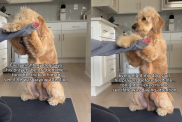Have you ever experienced the sight of a dog frantically pacing, whining, or diving for cover the instant thunder rumbles in the distance? Maybe you’ve come home to find that the happy dog you left playing in the backyard this morning has injured himself, and damaged your home, digging and clawing his way through a door to come inside. Or perhaps your dog simply plasters himself to your body, and trembles until a storm is over.
Any of these behaviors could be a sign that your dog has a thunderstorm phobia. Although animal behaviorists have studied this problem for years, its root cause is not totally known. Complicating the issue is the fact that thunderstorm phobia can develop late in life, often manifesting itself for the first time at age 7 or 8–possibly because older dogs experience some sort of pain when the barometric pressure drops, like an arthritic human being experiences when a storm is on the way.
Since there are many components to a storm (atmospheric changes, loud thunder, flashing lightning, hard rain pounding on the roof) it is hard to determine exactly what is frightening the dog.
There is some evidence that certain breeds of dogs may be more prone to fear of thunderstorms. An article in the July/August 2001 issue of Journal of American Animal Hospital Association cites a survey suggesting a genetic component. Herding dogs, which have been bred for higher reactivity, yet lower aggression, such as Collies or Australian Shepherds, may be at particular risk. This survey also indicated that working and sporting breeds, even hounds such as Beagles and Basset Hounds, may be more likely to be afraid of storms than other dogs.
Early-life experiences may also make dogs more likely to develop phobias. The JAAHA study indicated that dogs adopted from shelters or rescue organizations have a high incidence of thunderstorm phobias. These dogs may have lacked early socialization, causing them to be less confident and more likely to develop any type of phobia. However, there is also the possibility that they may have ended up in the shelter due to the fact that they exhibited destructive behaviors (due to their storm phobia) in their former homes.
So what can we do to help these dogs? A few respond to desensitization techniques, such as providing valued food rewards while being exposed to a tape recording of storm noises. These tapes are initially played very softly, increasing the volume only after the dog appears comfortable.
Unfortunately, noise is only part of the issue, and it is almost impossible to duplicate things such as changes in atmosphere. We can help reduce the possibility that static electricity is part of the issue by rubbing the dog all over with an anti-static dryer sheet. Rub the sheet on yourself as well, so you do not accidentally shock your dog when you touch him on a stormy day.
Be sure your dog is in a safe place if he must be left alone during a day when a storm is likely. Doggie daycare can be a good option during storm-prone months if your dog cannot be safely left in a crate or indoor area when you are away.
Exercise and certain supplements can be valuable in lowering anxiety of any type, so you may wish to try increasing your dog’s daily exercise (and therefore his endorphin level) during storm season. Make sure he is on a healthy diet, with supplements if needed.
Many dogs with thunderstorm phobias exhibit such extreme anxiety that medication must be considered, so be sure to consult your veterinarian for advice. A daily anti-anxiety medication (sometimes in the anti-depressant family) is often prescribed, with tranquilizers as needed on stormy days.
Also, although feelings of sympathy are normal, be careful not to accidentally reinforce your dog’s fearful behavior by coddling him during storms. If you remain calm and act as if there’s nothing to fear, it will help your dog stay relaxed, too.
Source: Adapted from the American Animal Hospital Association









